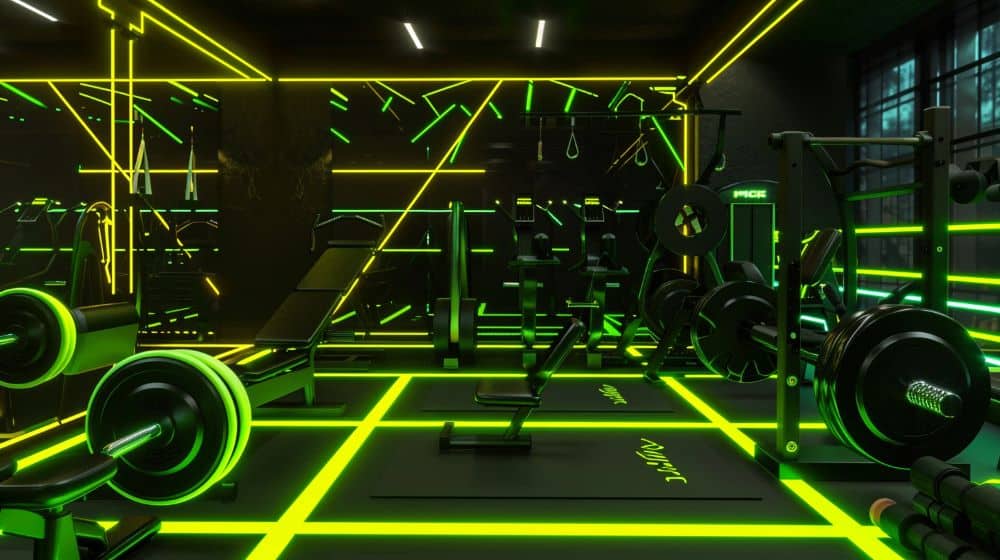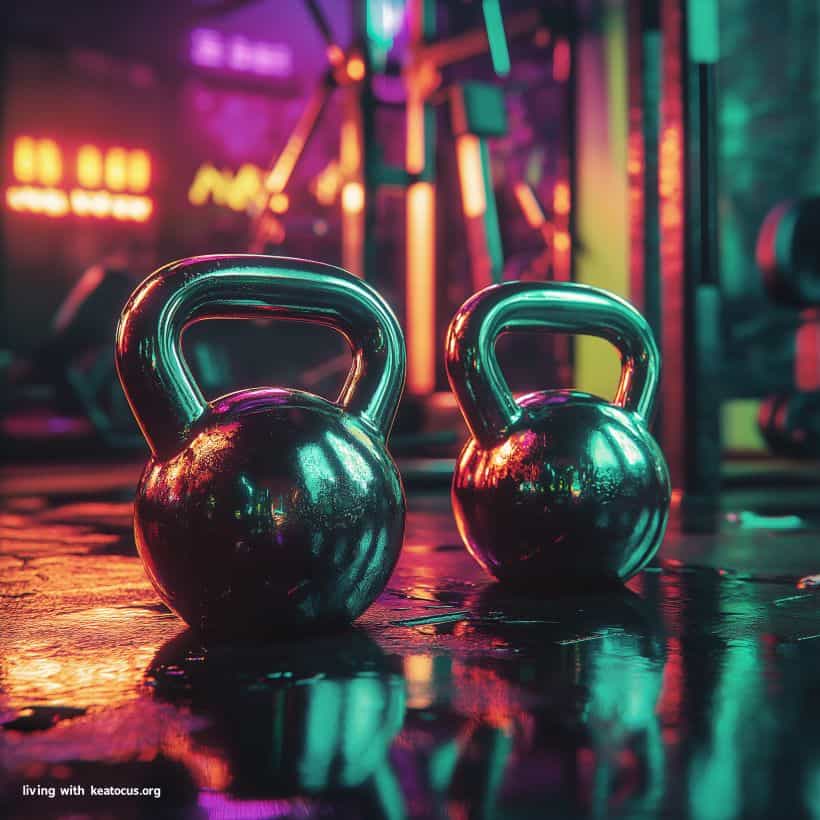
As someone who’s lived with keratoconus for over three decades and found joy in weightlifting, I understand the unique challenges we face. Weight lifters with keratoconus should prioritize proper breathing techniques to safeguard eye health and maximize the benefits of their workouts.
While there are many aspects to consider when weightlifting with keratoconus which I cover in my, 10 Essential Safety Tips, article), today we’re diving deep into one crucial element: proper breathing techniques, if you’re wondering, does exercise helps keratoconus?, the answer might surprise you.
Mastering your breath can help minimize intraocular pressure (IOP) spikes and protect our eye health while enjoying the benefits of strength training. Let’s explore how to breathe right and lift smart.
Disclaimer
The information provided in this article is based on my personal experience living with keratoconus for over three decades and my background as a fitness enthusiast.
While I strive to offer helpful insights, it’s important to note that I am not a medical professional. The proper breathing techniques for weight lifters with keratoconus discussed here should not be considered medical advice.
Every individual’s experience with keratoconus is unique, and what works for one person may not be suitable for another.
Before starting any new exercise regimen or modifying your current routine, it is important to consult with your ophthalmologist and a qualified fitness professional.
They can provide personalized guidance based on your specific condition, overall health, and fitness goals.
Remember, your eye health and safety should always be your top priority. If you experience any discomfort, pain, or changes in your vision during exercise, stop immediately and seek medical attention.
The Importance of Breath Control for Those of Us with Keratoconus
Before we dive into techniques, let’s understand why breathing matters so much to us:
- It helps stabilize our vision during lifts.
- It reduces overall stress on our eyes.
- It can help manage IOP(Intraocular pressure), which is important for corneal health.
Now, let’s get into the specifics of how to breathe properly during your weightlifting sessions.
Focus on Steady Breathing
Maintaining a steady breathing pattern throughout each exercise is key. Here’s what I’ve found works best:
- Inhale during the eccentric (lowering) phase of the lift.
- Exhale during the concentric (lifting) phase.
- Avoid holding your breath at any point.
This consistent rhythm helps keep our IOP stable and reduces eye strain. It’s a fundamental aspect of proper breathing techniques for weight lifters with keratoconus.
Exhale on Exertion
When pushing or pulling the weight, focus on exhaling. This technique helps keep IOP increases to a minimum. For example:
- Exhale when pushing the bar up during a bench press.
- Exhale when standing up during a squat.
- Exhale when pulling the bar up during a deadlift.
Remember, this breathing technique is just one part of safe weightlifting with keratoconus. For a full safety overview, check out my 10 Essential Safety Tips for Weight Lifting with Keratoconus article.
Inhale During the Eccentric Phase
Take a deep, controlled breath as you lower the weight. This prepares your body for the lift and helps maintain stable eye pressure.
Exhale During the Concentric Phase
As you lift the weight, exhale slowly and steadily. This controlled exhalation is a key component of proper breathing techniques for weight lifters with keratoconus.
Avoid Breath Holding
It’s tempting to hold your breath during difficult lifts, but this can cause dangerous IOP spikes. Keep your breathing steady and continuous to protect your eyes.
The Mindful Breathing Technique
While not specifically for weightlifting, the breathing technique has shown promise in reducing IOP for glaucoma patients. I’ve incorporated it into my daily routine with positive results:
- Take slow, deep breaths for 5 minutes, three times a day.
- Breathe at a rate of six cycles per minute.
- Inhale for 5 seconds through the nose and exhale for 10 seconds through the mouth.
This technique may help manage overall IOP levels, potentially benefiting your weightlifting sessions as well.
Consider practicing this before your workouts to get into a good breathing rhythm.
Benefits of Proper Breathing During Weightlifting
Understanding why these techniques work can help motivate us to maintain good habits:
Regulates Intra-abdominal Pressure
Exhaling during the lifting phase helps control pressure buildup in your abdomen and chest, reducing the risk of internal injuries and minimizing stress on your eyes.
Improves Performance and Control
Proper exhalation enhances stability and power throughout the movement. I’ve noticed significant improvements in my lifts since focusing on this technique, which is especially important for those of us with keratoconus.
Enhances Safety
Controlled exhalation is safer than breath-holding, preventing blood pressure spikes and ensuring a steady oxygen supply to your muscles.
This practice plays a vital role in maintaining stable eye pressure during your workout, which is especially important for those of us with keratoconus.
Promotes Proper Technique
Focusing on exhaling during exertion has helped me maintain better form and engage the right muscles throughout each lift. Good form is essential for safe weightlifting, especially with keratoconus.
Supports Natural Body Mechanics
This breathing pattern aligns with our body’s instinctive mechanisms for generating force and stability during weightlifting, which can help reduce overall stress on your body and eyes.
Integrating Breathing Techniques with Other Safety Measures
Mastering these breathing techniques is essential for safe weightlifting with keratoconus, but it’s important to remember that they’re just one part of a comprehensive approach. Other key aspects to consider include:
- Using appropriate eye protection.
- Start with lighter weights and shorter sets.
- Taking adequate rest between sets.
- Staying well-hydrated.
- Listening to your body and monitoring your symptoms.
Key Takeaways

Before we wrap up, let’s review the essential points about proper breathing techniques for weight lifters with keratoconus:
- Maintain steady breathing throughout your exercises: inhale during the eccentric phase and exhale during the concentric phase.
- Focus on exhaling during exertion to minimize intraocular pressure spikes.
- Consider incorporating the mindful breathing technique into your daily routine to help manage overall IOP levels.
- Proper breathing offers multiple benefits: regulates intra-abdominal pressure, improves performance, enhances safety, promotes proper technique, and supports natural body mechanics.
- Remember that breathing techniques are just one part of a comprehensive approach to safe weightlifting with keratoconus.
- Always consult with your eye doctor and a qualified fitness professional for personalized advice.
By mastering these breathing techniques and integrating them with other safety measures, you can enjoy the benefits of weightlifting while managing your keratoconus effectively.
To Summarize
By incorporating these proper breathing techniques for weight lifters with keratoconus into your routine, you can protect your eyes, improve your performance, and enjoy the benefits of strength training despite living with this condition.
Remember to consult with your eye doctor and a qualified fitness professional for personalized advice based on your specific condition and fitness goals.
As someone who’s been on this journey for years, I can attest to the difference proper breathing makes. It’s allowed me to continue pursuing my passion for weightlifting while managing my keratoconus effectively. Stay strong, breathe right, and keep lifting!
Remember, this guide focuses specifically on breathing techniques. For a comprehensive overview of weightlifting safety with keratoconus, including eye protection, weight selection, and more, be sure to read my 10 Essential Safety Tips article.
Together, these resources will help you build a safe and effective weightlifting routine that respects the needs of your eyes.
If you’re still curious about whether exercise can benefit your keratoconus, explore our article Does Exercise Help Keratoconus? to learn more about the potential positive impacts of physical activity on your eye health.